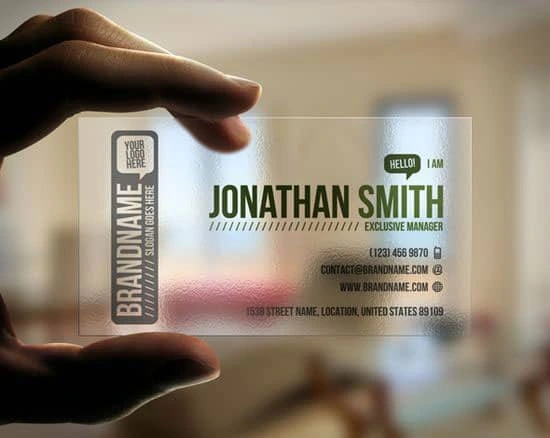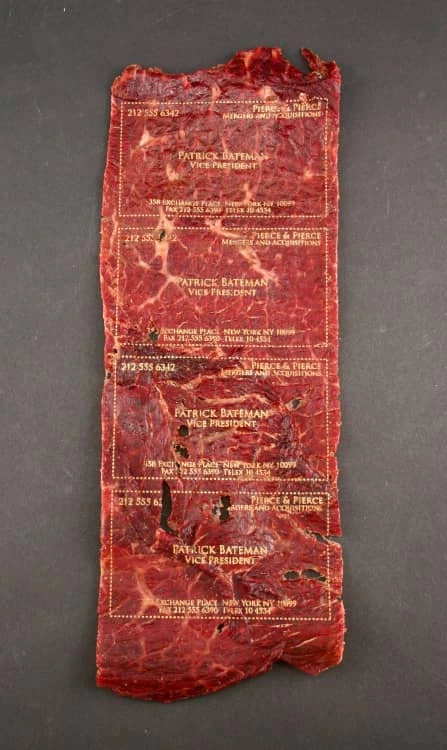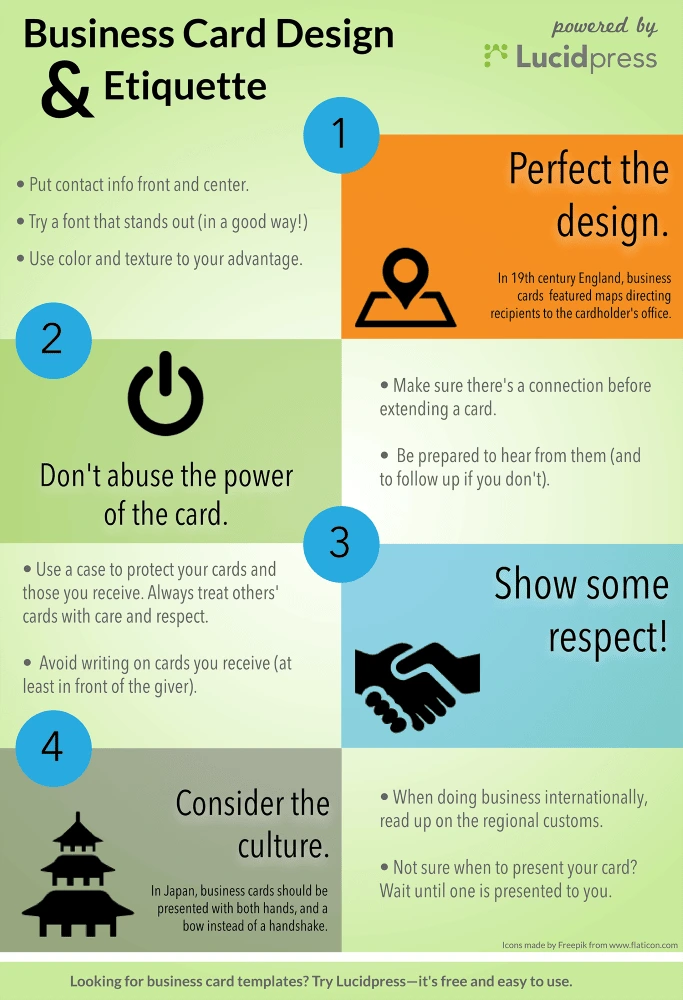Business cards originated in China in the fifteenth century. Back then, they were known as “meishi.” Today they are perhaps the most freely distributed commodity in the business world, as well as an essential part of your DIY marketing toolkit. But business cards can’t help you network if you don’t use them wisely. This post will give you 4 tips on business card etiquette so you can get the most mileage out of each card.
Related: 30 creative business card ideas & designs to help yours stand out
1. Perfect your business card design
To be a true master of business card technique, you must first have a standout business card. Your card is you at a glance, and you want that first impression to be positive and clear. In essence, you’re creating a personal brand that speaks to people, just as you would. Look at others’ business cards to get inspiration, and learn how to create your own personal logo. Then, use Lucidpress to create your own from scratch or from one of our free business card templates.
We can learn one business card lesson from nineteenth-century England. At that time, business cards were referred to as “trade cards,” and they featured a map intended to direct potential customers to the cardholder’s business. Your business cards should do the same thing: get potential customers in touch with you ASAP.
Make sure you put the most important information front and center in a font that stands out. You can also creatively use color to your advantage, keeping in mind that different colors have different psychological effects.
When it comes to business cards, the possibilities are nearly endless. You can put shiny lettering and inventive textures, or forge your business card out of pure platinum and install a tiny speaker that announces your name and title when your card senses the touch of fingerprints. Hey, one can dream.

Photo from Overflow Graphics
All right, the last option is a little out there, but there’s no doubt that you have a lot of options. If you design your business card with Lucidpress, you can even add a photo and a QR code. All of this can help people remember you and increase your chances of hearing from them.
As a final note on design, don’t forget to give serious thought to the material you use. Perhaps you’ve fought the losing battle of trying to write on a glossy card that deflects ink like it’s the plague. A poor paper choice can throw off your whole business card mojo. After designing your card in Lucidpress, you can take your design to your favorite printing shop or order prints directly from us. These days, your business card can even be edible. Whether or not you choose to go this route, your design should be so sumptuous that people have to restrain themselves from taking a bite.

Photo from Meat Cards
2. Don’t abuse the power of the card
A well-designed, well-placed business card can be an invaluable tool. But like money, business cards can suffer from inflation: if you give too many of them out, their value will go down. On the other hand, a thoughtful approach preserves the strength of the business card as an ace networking and marketing tool.
If someone walks up to you, smiles and hands you their business card, that card probably won’t be remembered for long, even if the person who gave it to you had a really nice smile. The truth is that, without some sort of a connection made before the exchanging of cards, both parties will soon forget about the whole thing. Humans are social beings, and a business card is powerful because it is a representation of an actual person you can see and talk with.
So what happens if you abuse the power of the card? Well, not to get all doom-and-gloom, but negative side effects may include a cheapening of your professional image, irrelevant emails and phone calls that waste everyone’s time, and loss of credibility.
3. Observe business etiquette
It’s also important to respect others’ cards. It’s a good idea to avoid writing on a card in front of the giver unless it’s related to a request they made (or something similar). Use your best judgement.
The point is that you never want someone to feel used, so instead of writing down how someone can help you, chat about how you can help them. The way you store your card and the cards that are given to you will be a reflection of your professionalism and respect. You spent a lot of time deciding on a card that presents you in a positive way, and most everyone else has thought a lot about that, too. So give your cards some love by keeping them in a case.
When someone gives you one of their business cards, take some time to look it over, then find somewhere to put it that communicates respect to the giver. [![]() ] A card case will work perfectly, and if that’s not an option, your best bet is to either hold onto the card until the conversation is over or thoughtfully place the card in your suit pocket or purse. Business etiquette goes a long way.
] A card case will work perfectly, and if that’s not an option, your best bet is to either hold onto the card until the conversation is over or thoughtfully place the card in your suit pocket or purse. Business etiquette goes a long way.
4. Consider the culture
Business card customs are fairly informal in the United States, but there are specific rules and norms in other countries that are important to observe. For example, if you are doing business in Japan, you should know that business cards are seen as an extension of the individual to which they belong.
Also, be sure to not shake hands when exchanging business cards in Japan. A small bow is the way to go, and it’s best to present your business card with both hands. When doing any kind of international business, take some time to familiarize yourself with the customs of the country you’ll be working in. A little research can help you save face down the road.
Now you’re ready to conquer the business world with your finely-tuned business card savvy.
You’ve got this! If you liked what you learned today, feel free to share this handy infographic.




